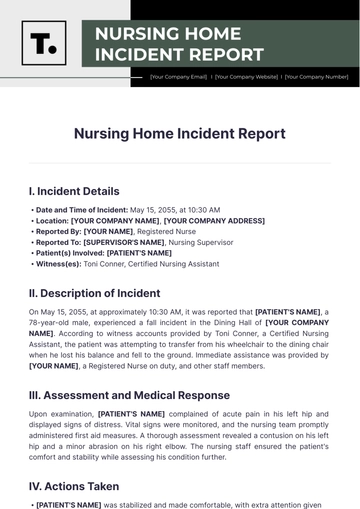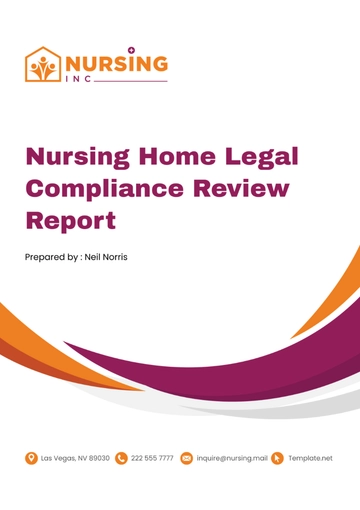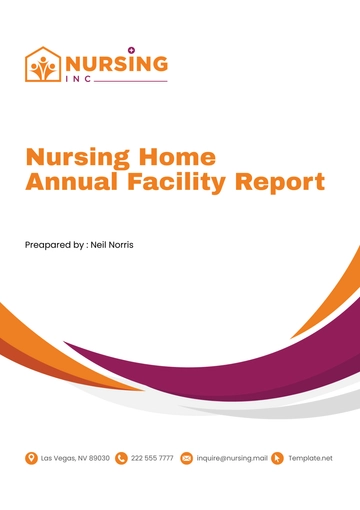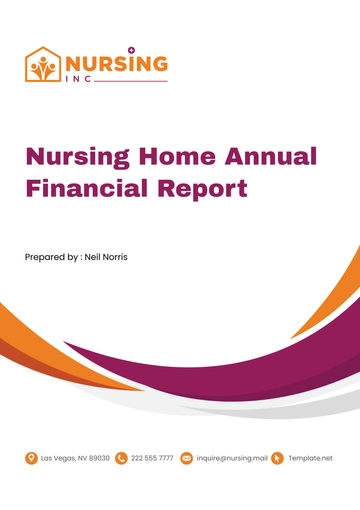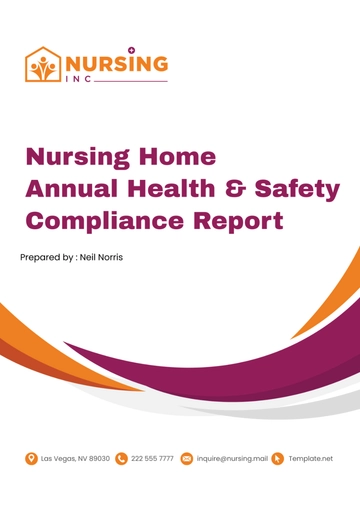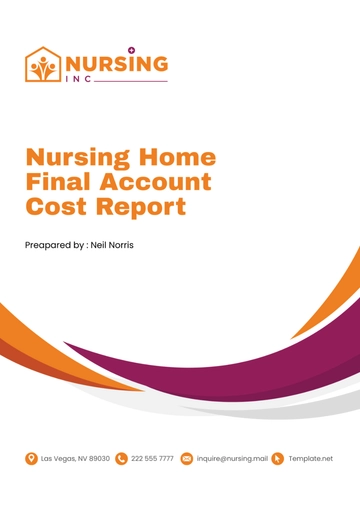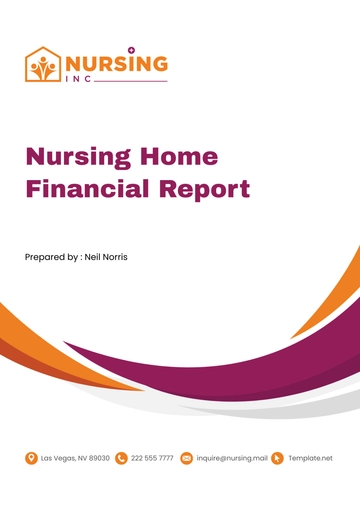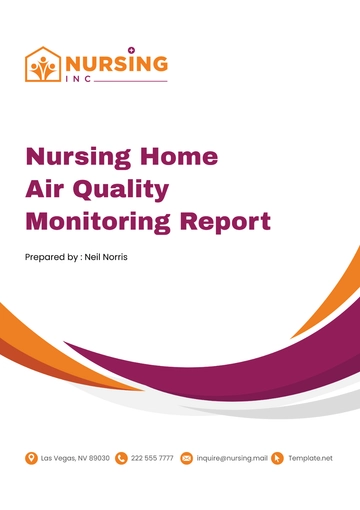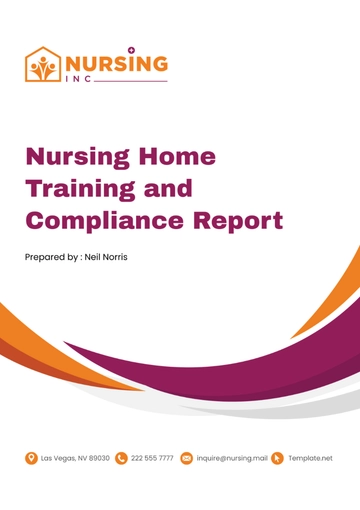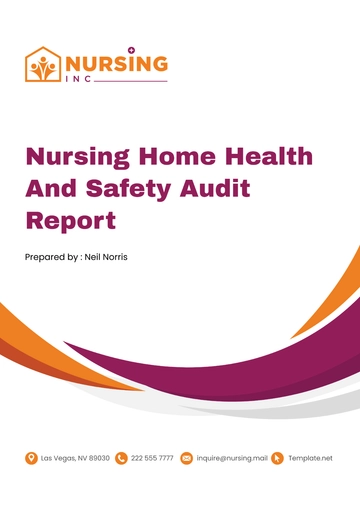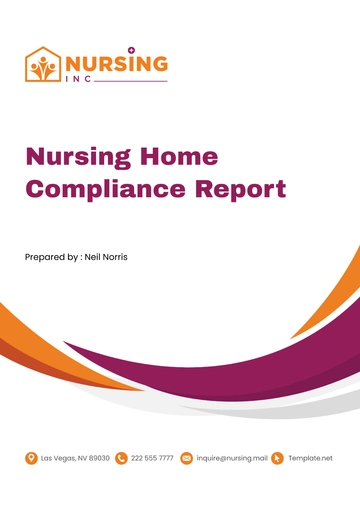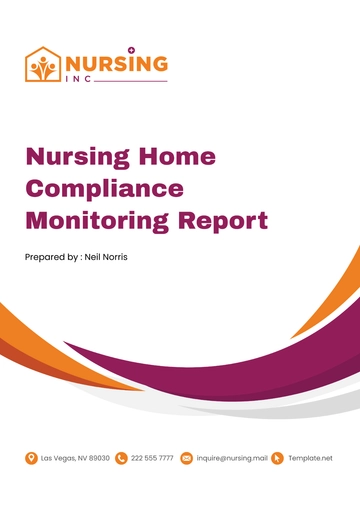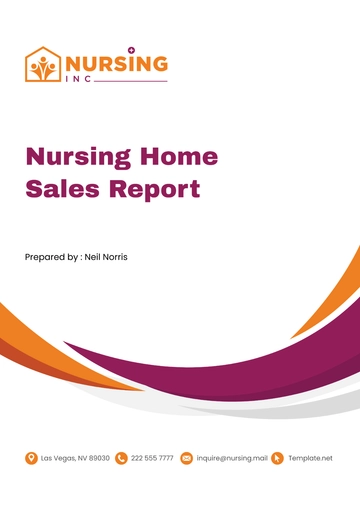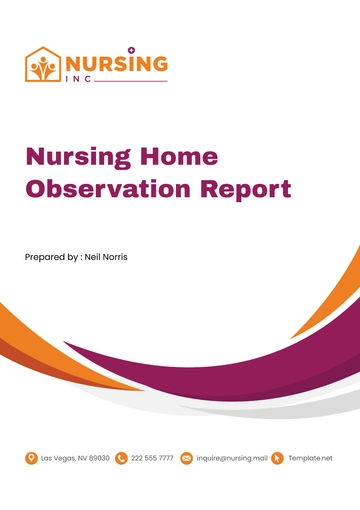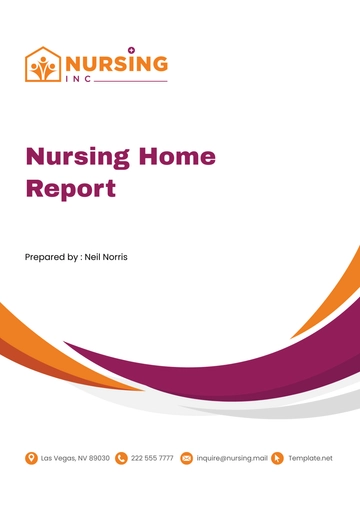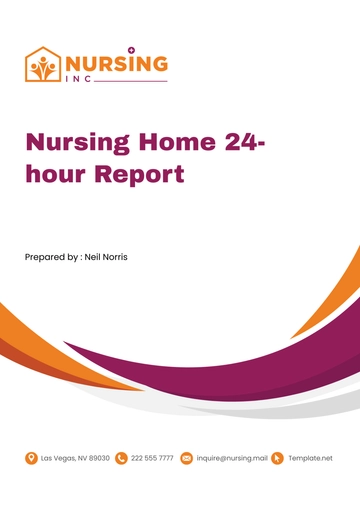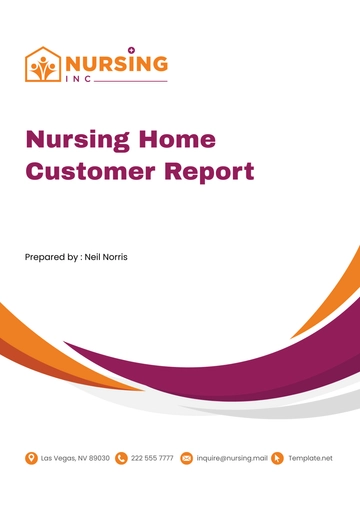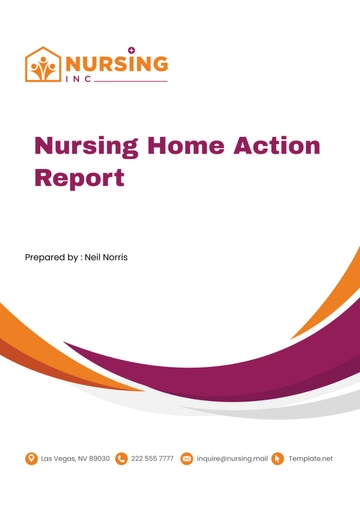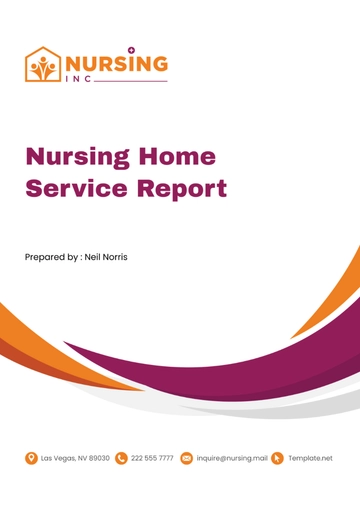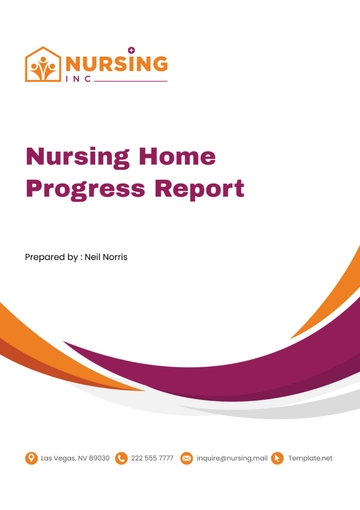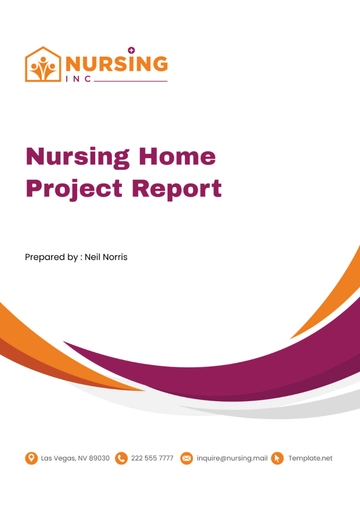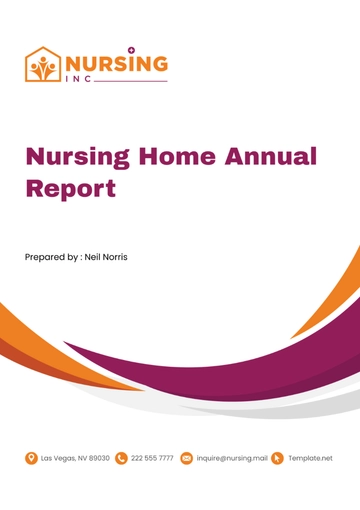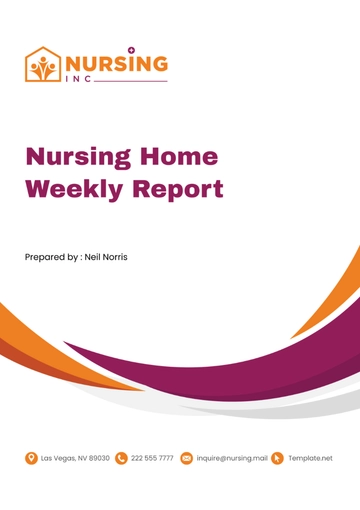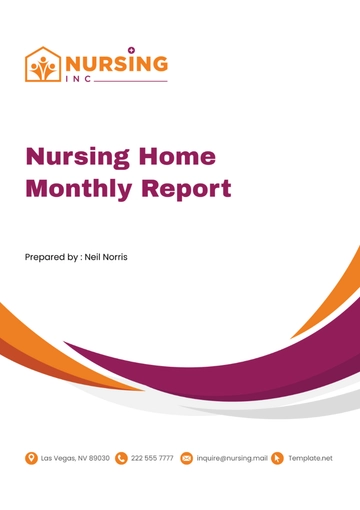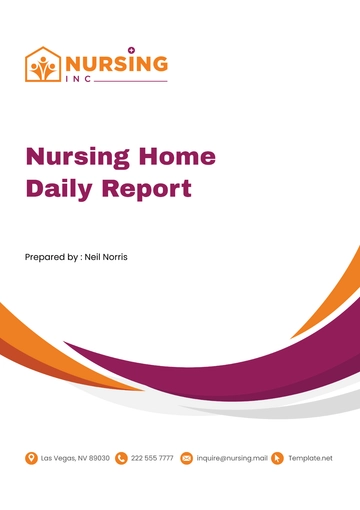Free Nursing Home Training and Compliance Report
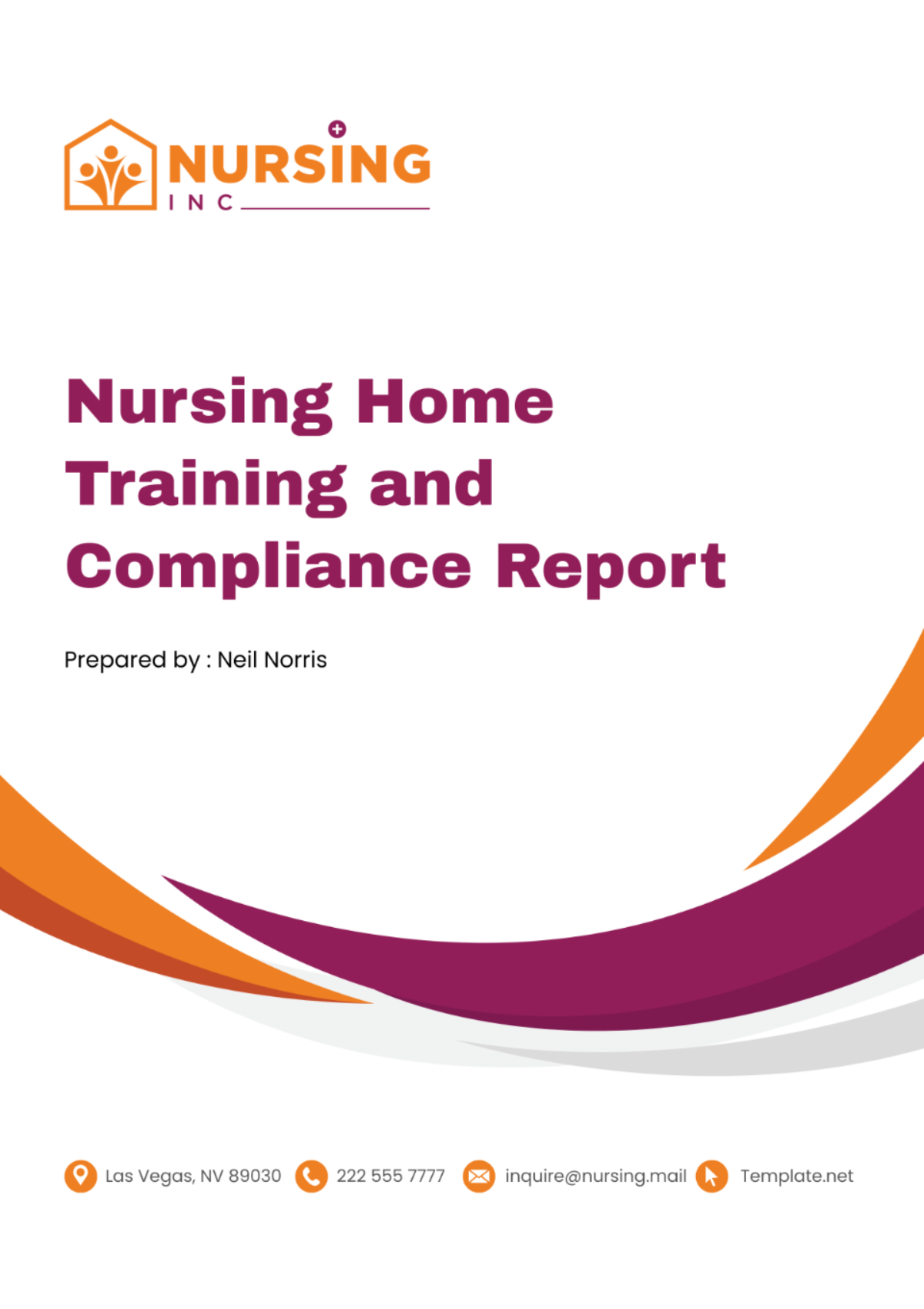
I. Introduction
The purpose of this report is to provide a comprehensive overview of the training and compliance measures undertaken at [Your Company Name]. It aims to highlight the importance of regular training and strict compliance in maintaining the highest standards of care in our nursing home.
A. Purpose of the Report
Highlighting Importance: The report underscores the importance of training and compliance in a nursing home setting. It emphasizes how these two elements are crucial in maintaining a high standard of care. The report serves as a testament to our commitment to quality care and our dedication to continuous improvement.
Providing Overview: The report provides an overview of the training sessions conducted and the compliance measures implemented at [Your Company Name]. This overview is intended to give a clear picture of our efforts to ensure that our staff are well-trained and that our operations adhere to all necessary regulations and standards.
Setting Expectations: The report sets the expectations for the quality of care at [Your Company Name] by outlining the training and compliance measures in place. It serves as a benchmark for our performance and a guide for our future efforts.
B. Importance of Training and Compliance
Maintaining High Standards: Regular training ensures that our staff are equipped with the latest best practices, while a robust compliance system ensures transparency, improves patient outcomes, and minimizes liability. These elements are integral to our operations and are key to maintaining the high standards of care that we are known for.
Ensuring Quality Care: Training and compliance are critical for ensuring that the residents of [Your Company Name] receive the highest quality of care. They ensure that our staff are well-prepared to meet the needs of our residents and that our operations are conducted in a manner that prioritizes the well-being of our residents.
Reducing Risks: Compliance with regulations and standards reduces the risk of errors and violations, which can lead to penalties and damage to our reputation. By adhering to these standards, we can provide a safe and comfortable environment for our residents and maintain the trust of their families and the community.
C. Scope of the Report
Comprehensive Analysis: The report includes a comprehensive analysis of our training programs and compliance measures. It delves into the specifics of our training sessions, including their frequency, target personnel, and overall effectiveness. It also examines the status of compliance in various areas, the parties responsible for ensuring compliance, and any notable comments or issues.
Focus on Improvement: The report is not just a presentation of facts but also a tool for improvement. It identifies areas where we are doing well and areas where there is room for improvement. This focus on improvement is what drives us to continuously enhance our training programs and compliance measures.
Future Planning: The report also serves as a basis for future planning. The insights gained from the report will guide us in making decisions about future training programs and compliance measures. It will help us ensure that our efforts are aligned with our goal of providing the highest quality of care to our residents.
II. Methodology
The methodology of this report involves a thorough review of our training programs and compliance measures. It is designed to provide a comprehensive understanding of the training and compliance landscape at [Your Company Name].
A. Review of Training Programs
Scope of Review: The review covers all training programs conducted at [Your Company Name]. It includes both mandatory training for all staff and role-specific training for different positions.
Training Evaluation: Each training program is evaluated based on its content, delivery method, frequency, and effectiveness. This evaluation helps us understand the strengths and weaknesses of our training programs.
Feedback Collection: Feedback from staff who have undergone the training is also collected and analyzed. This feedback provides valuable insights into the practicality and applicability of the training programs.
Outcome Measurement: The outcomes of the training programs, such as improvements in skills or knowledge, are also measured. This helps us understand the impact of our training programs on staff performance and resident care.
Continuous Improvement: Based on the review, recommendations are made for improving the training programs. This continuous improvement approach ensures that our training programs remain relevant and effective.
B. Examination of Compliance Measures
Compliance Areas: The examination covers all areas of compliance, including resident rights, infection control, staffing, food service, and medication management. This comprehensive approach ensures that all aspects of our operations are compliant with regulations and standards.
Compliance Monitoring: We monitor compliance through regular audits, inspections, and reviews. This helps us identify any areas of non-compliance and take corrective action promptly.
Responsibility Assignment: The responsibility for ensuring compliance in each area is assigned to a specific department or individual. This clear assignment of responsibility ensures accountability and facilitates effective compliance management.
Issue Resolution: Any issues or non-compliance identified during the examination are documented and resolved. This includes developing and implementing action plans to address the issues and prevent recurrence.
Compliance Reporting: Regular compliance reports are prepared and shared with relevant stakeholders. These reports provide transparency and help us maintain a culture of compliance.
C. Data Collection and Analysis
Data Sources: Data for this report is collected from various sources, including training records, compliance reports, staff feedback, and outcome measurements. This ensures that the report is based on accurate and up-to-date information.
Data Analysis: The collected data is analyzed to identify trends, patterns, and areas of concern. This analysis forms the basis for the findings and recommendations in the report.
Data Presentation: The data is presented in a clear and understandable manner, using tables, charts, and graphs where appropriate. This helps stakeholders understand the data and make informed decisions.
III. Training
Training is a critical component of our operations at [Your Company Name]. It ensures that our staff are equipped with the necessary skills and knowledge to provide the highest quality of care to our residents. The following table provides a detailed overview of the various training programs we conduct:
Training Type | Target Personnel | Frequency | Overall Effectiveness |
|---|---|---|---|
Basic Care Training | Nursing Staff | Bi-annual | High |
Advanced Care Training | Clinical Staff | Annual | High |
Resident Rights | All Staff | Quarterly | Average |
Emergency Procedures | All Staff | Annual | High |
Nursing Home Administration | Administrative Staff | Annual | High |
A. Basic Care Training
Basic Care Training, targeted at our nursing staff and conducted bi-annually, has been rated highly effective. This training covers the fundamental aspects of care that our nursing staff provide daily. It includes modules on personal hygiene, mobility assistance, feeding, and basic medical care. The high effectiveness rating indicates that our nursing staff find this training valuable and relevant to their roles.
B. Advanced Care Training
Advanced Care Training is designed for our clinical staff and is conducted annually. This training delves into more complex care procedures and medical tasks that our clinical staff are responsible for. The high effectiveness rating suggests that our clinical staff are gaining significant skills and knowledge from this training, enhancing their ability to provide advanced care to our residents.
C. Resident Rights
Resident Rights training is provided to all staff on a quarterly basis. This training ensures that all staff members are aware of and respect the rights of our residents. The average effectiveness rating indicates that while this training is beneficial, there may be room for improvement in how it is delivered or the content it covers.
D. Emergency Procedures
Emergency Procedures training is also provided to all staff annually. This training covers the procedures to be followed in various emergency situations, ensuring that all staff can respond effectively when needed. The high effectiveness rating indicates that our staff feel well-prepared to handle emergencies as a result of this training.
E. Nursing Home Administration
Nursing Home Administration training is specifically for our administrative staff and is conducted annually. This training covers the administrative tasks necessary for the smooth operation of our nursing home. The high effectiveness rating suggests that our administrative staff find this training useful in performing their roles efficiently.
The training programs at [Your Company Name] are designed to equip our staff with the necessary skills and knowledge to perform their roles effectively. Each training program is tailored to the needs of the target personnel, ensuring that they receive relevant and useful training. The frequency of the training programs ensures that our staff’s skills and knowledge remain up-to-date.
The effectiveness ratings of the training programs provide valuable insights into their impact. High effectiveness ratings for most of the training programs indicate that our staff find the training valuable and relevant. This suggests that our training programs are succeeding in enhancing our staff’s abilities and confidence in their roles.
However, the average effectiveness rating for the Resident Rights training indicates room for improvement. We could consider revising the content or delivery of this training to make it more engaging and effective. Regardless, the overall high effectiveness ratings for our training programs are a testament to their quality and relevance.
IV. Compliance
Compliance is a critical aspect of operations at [Your Company Name]. It ensures that we adhere to all necessary regulations and standards, thereby maintaining the highest level of care in our nursing home. The following table provides a detailed overview of our compliance measures:
Compliance Area | Status | Responsible Party | Comment |
|---|---|---|---|
Resident Rights | Compliant | Legal Department | No issues found |
Infection Control | Compliant | Clinical Department | No infections reported |
Staffing | Non-Compliant | Human Resources | Resolving staffing shortage |
Food Service | Compliant | Catering Department | No safety concerns |
Medication Management | Compliant | Pharmacy Department | No medication errors |
A. Resident Rights
Our nursing home is compliant with all regulations pertaining to resident rights. The legal department is responsible for ensuring this compliance. The fact that no issues have been found in this area is a testament to our commitment to respecting and upholding the rights of our residents. This includes their right to privacy, dignity, and access to quality care.
B. Infection Control
Infection control is another area where we are fully compliant, with no infections reported. The clinical department oversees this aspect of compliance, ensuring that all necessary precautions and procedures are in place to prevent the spread of infections. This is crucial for maintaining the health and safety of our residents and staff.
C. Staffing
Staffing is an area where we are currently non-compliant, but efforts are underway by the Human Resources department to resolve this issue. Adequate staffing levels are essential for providing quality care to our residents. We are actively recruiting to fill vacancies and are confident that this issue will be resolved soon.
D. Food Service
Our food service is compliant with all relevant regulations, with no safety concerns reported. The catering department is responsible for this area of compliance. They ensure that meals are prepared hygienically and that dietary requirements of residents are catered for, contributing to the overall well-being of our residents.
E. Medication Management
We are also compliant in the area of medication management, with no medication errors reported. The pharmacy department oversees this aspect of compliance, ensuring that medications are managed safely and effectively. This is vital for maintaining the health of our residents and preventing any medication-related issues.
The compliance measures at [Your Company Name] reflect our commitment to providing a safe and high-quality care environment for our residents. Each compliance area is closely monitored and managed by a dedicated party, ensuring accountability and effective management.
It is important to note that compliance is not a one-time task, but an ongoing commitment. It requires regular reviews and updates to ensure that we continue to meet all necessary standards and regulations. This commitment to compliance is a reflection of our dedication to our residents and our mission to provide them with the highest quality of care.
In conclusion, compliance is a critical aspect of our operations at [Your Company Name]. By adhering to all necessary regulations and standards, we can ensure the highest quality of care for our residents and a safe, supportive work environment for our staff. We will continue to review and improve our compliance measures to ensure they meet the evolving needs of our staff and residents.
V. Recommendations
Based on the findings from our review of the training programs and compliance measures at [Your Company Name], we have several recommendations. These recommendations are designed to enhance the effectiveness of our training programs and improve compliance in all areas:
A. Training Program Enhancements
Update Training Content: We recommend regularly updating the content of our training programs to ensure they remain relevant and up-to-date with the latest best practices in nursing home care.
Increase Frequency of Resident Rights Training: Given the average effectiveness rating of the Resident Rights training, we suggest increasing its frequency to improve understanding and application among all staff.
Implement Role-Specific Training: We recommend implementing more role-specific training programs. This will ensure that each staff member receives training that is directly relevant to their role and responsibilities.
Introduce Interactive Training Methods: To make the training sessions more engaging and effective, we suggest introducing more interactive training methods, such as workshops, simulations, and group discussions.
Continuous Evaluation and Improvement: We recommend continuously evaluating the effectiveness of our training programs and making necessary improvements based on feedback from staff and changes in nursing home care practices.
B. Compliance Measures Improvements
Address Staffing Issue: Given the non-compliance status in staffing, we recommend taking immediate action to resolve this issue. This could involve recruiting more staff or optimizing the current staffing schedule.
Regular Compliance Audits: We suggest conducting regular compliance audits to identify any potential areas of non-compliance at an early stage. This will allow us to take corrective action promptly.
Compliance Training: We recommend introducing regular compliance training for all staff to ensure they are aware of the regulations and standards they need to adhere to.
Establish a Compliance Committee: We suggest establishing a compliance committee that will be responsible for overseeing all compliance-related activities. This committee can also serve as a point of contact for staff who have any compliance-related questions or concerns.
Develop a Compliance Manual: We recommend developing a comprehensive compliance manual that clearly outlines all the compliance policies and procedures. This manual can serve as a valuable resource for all staff.
C. General Recommendations
Promote a Culture of Continuous Learning: We recommend promoting a culture of continuous learning within [Your Company Name]. This can be achieved by encouraging staff to participate in ongoing training and providing them with opportunities for professional development.
Encourage Feedback: We suggest encouraging staff to provide feedback on both the training programs and compliance measures. This feedback can provide valuable insights for improving these areas.
Regular Reviews: We recommend conducting regular reviews of both the training programs and compliance measures to ensure they remain effective and relevant.
VI. Conclusion
The training and compliance endeavors at [Your Company Name] continue to reflect our commitment to providing exceptional service to our residents. Our comprehensive training programs ensure that our staff are equipped with the necessary skills and knowledge to provide high-quality care. Meanwhile, our robust compliance measures ensure that we adhere to all necessary regulations and standards, thereby maintaining the highest level of care in our nursing home.
A. Reflection on Training and Compliance Efforts
Effective Training Programs: Our training programs, ranging from basic care training to advanced care training, have proven to be highly effective in equipping our staff with the necessary skills and knowledge. The high effectiveness ratings for most of the training programs indicate that our staff find the training valuable and relevant.
Strong Compliance Measures: Our strong compliance measures, as evidenced by the compliance status in various areas, demonstrate our commitment to adhering to all necessary regulations and standards. The fact that we are compliant in most areas is a testament to the effectiveness of our compliance measures.
Continuous Improvement: The continuous improvement approach adopted in both our training programs and compliance measures ensures that we are always striving to enhance our performance. The recommendations provided in this report are a reflection of this commitment to continuous improvement.
B. Looking Forward
Ongoing Commitment: As we move forward, we remain committed to providing the highest quality of care to our residents. This involves continuously enhancing our training programs and compliance measures to ensure they meet the evolving needs of our staff and residents.
Future Improvements: We look forward to implementing the recommendations provided in this report and making further improvements in our operations. We believe that these improvements will enhance the quality of care we provide and contribute to a positive and supportive work environment.
Continued Excellence: We are confident that with our ongoing commitment to training and compliance, we will continue to uphold the high standards of care that [Your Company Name] is known for. We are grateful for the dedication and hard work of our staff, and we look forward to continuing our journey towards excellence in care.
Overall, the training and compliance measures at [Your Company Name] play a crucial role in ensuring the highest quality of care for our residents. We are proud of our achievements in these areas and are committed to maintaining and enhancing these standards in the future. We believe that with the right training and compliance measures in place, we can ensure a safe, supportive, and caring environment for our residents.
- 100% Customizable, free editor
- Access 1 Million+ Templates, photo’s & graphics
- Download or share as a template
- Click and replace photos, graphics, text, backgrounds
- Resize, crop, AI write & more
- Access advanced editor
Ensure compliance with regulations and standards with our versatile and editable Nursing Home Training and Compliance Report Template available on Template.net! This customizable resource ensures easier reporting training and compliance efforts within your facility. Utilize the AI Editor Tool to generate detailed reports that demonstrate adherence to regulatory requirements easily!
You may also like
- Sales Report
- Daily Report
- Project Report
- Business Report
- Weekly Report
- Incident Report
- Annual Report
- Report Layout
- Report Design
- Progress Report
- Marketing Report
- Company Report
- Monthly Report
- Audit Report
- Status Report
- School Report
- Reports Hr
- Management Report
- Project Status Report
- Handover Report
- Health And Safety Report
- Restaurant Report
- Construction Report
- Research Report
- Evaluation Report
- Investigation Report
- Employee Report
- Advertising Report
- Weekly Status Report
- Project Management Report
- Finance Report
- Service Report
- Technical Report
- Meeting Report
- Quarterly Report
- Inspection Report
- Medical Report
- Test Report
- Summary Report
- Inventory Report
- Valuation Report
- Operations Report
- Payroll Report
- Training Report
- Job Report
- Case Report
- Performance Report
- Board Report
- Internal Audit Report
- Student Report
- Monthly Management Report
- Small Business Report
- Accident Report
- Call Center Report
- Activity Report
- IT and Software Report
- Internship Report
- Visit Report
- Product Report
- Book Report
- Property Report
- Recruitment Report
- University Report
- Event Report
- SEO Report
- Conference Report
- Narrative Report
- Nursing Home Report
- Preschool Report
- Call Report
- Customer Report
- Employee Incident Report
- Accomplishment Report
- Social Media Report
- Work From Home Report
- Security Report
- Damage Report
- Quality Report
- Internal Report
- Nurse Report
- Real Estate Report
- Hotel Report
- Equipment Report
- Credit Report
- Field Report
- Non Profit Report
- Maintenance Report
- News Report
- Survey Report
- Executive Report
- Law Firm Report
- Advertising Agency Report
- Interior Design Report
- Travel Agency Report
- Stock Report
- Salon Report
- Bug Report
- Workplace Report
- Action Report
- Investor Report
- Cleaning Services Report
- Consulting Report
- Freelancer Report
- Site Visit Report
- Trip Report
- Classroom Observation Report
- Vehicle Report
- Final Report
- Software Report
